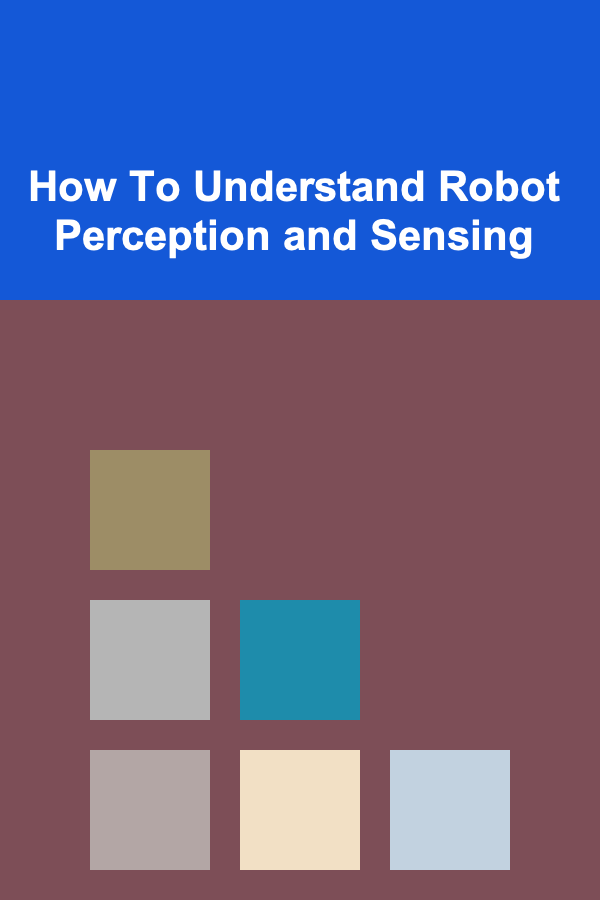
How To Understand Robot Perception and Sensing
ebook include PDF & Audio bundle (Micro Guide)
$12.99$10.99
Limited Time Offer! Order within the next:

The field of robotics has seen remarkable progress over the past few decades, driven by advances in artificial intelligence (AI), machine learning, and sensing technologies. One of the core components of autonomous robots is their ability to perceive and sense their environment. Robot perception and sensing allow robots to gather data from the outside world, process that information, and make decisions about how to interact with their surroundings.
In this article, we will delve into the fundamentals of robot perception and sensing, exploring how robots perceive their environment, the technologies that enable this perception, and how these sensors and systems work together to facilitate robotic autonomy. We will also discuss the challenges and advancements in robot perception, as well as real-world applications where these technologies are being used.
What Is Robot Perception?
Robot perception refers to the ability of a robot to interpret data gathered from sensors and other input sources to understand its surroundings. In simpler terms, it is the robot's "senses" and how it processes and makes sense of the information it gathers. Just like humans use their senses---sight, hearing, touch, and smell---to understand the world around them, robots use sensors to perceive their environment.
Perception is crucial for robots to interact intelligently with the world. Without it, a robot would be unable to navigate, recognize objects, or interact with humans or other machines. The process involves several stages:
- Data Collection: Robots collect data from their sensors, such as cameras, lidar, radar, and infrared sensors.
- Data Processing: The raw data is processed to extract useful information. For example, an image from a camera may be processed to detect and recognize objects.
- Interpretation: The robot makes sense of the processed data and builds a model of the environment, which helps it make decisions about how to proceed.
Types of Sensors in Robot Perception
Robots rely on a wide range of sensors to perceive their environment. The choice of sensors depends on the task the robot is performing, the environment it is in, and the level of complexity required for the task. Below are the key types of sensors commonly used in robot perception:
1. Cameras
Cameras are one of the most common sensors used in robotics. They capture visual information about the robot's environment, much like human eyes. Cameras can be used for tasks such as object detection, face recognition, and navigation.
- Monocular Cameras: These capture a single viewpoint and can provide 2D images. However, monocular cameras lack depth perception.
- Stereo Cameras: These use two cameras placed at different positions to capture images from different angles, allowing depth perception and 3D reconstruction of objects.
- Depth Cameras: These cameras, such as those based on structured light or time-of-flight sensors, can directly measure the distance to objects, providing 3D data.
2. Lidar (Light Detection and Ranging)
Lidar is a sensor that uses laser light to measure distances to objects. It is widely used in robotics for creating 3D maps of the environment and for obstacle detection.
Lidar sensors emit laser beams and measure how long it takes for the light to bounce back from objects. The time-of-flight data is then converted into a distance measurement. Lidar provides high-resolution, accurate 3D data and is useful in applications like autonomous vehicles and mobile robots in dynamic environments.
3. Radar (Radio Detection and Ranging)
Radar sensors operate similarly to lidar, but instead of using laser light, they use radio waves. Radar is less affected by environmental conditions such as fog, rain, or low light, which makes it a valuable sensing tool for outdoor environments and in situations where lidar and cameras may struggle.
Radar sensors are commonly used in autonomous vehicles for detecting the speed and distance of objects, such as other vehicles or pedestrians.
4. Infrared Sensors
Infrared (IR) sensors detect heat emitted by objects. They are particularly useful in low-light conditions and can be used for object detection and tracking.
Thermal cameras, which operate using infrared radiation, are often used in search and rescue missions, surveillance, and healthcare robots to detect heat signatures, such as humans or animals.
5. Ultrasonic Sensors
Ultrasonic sensors use sound waves to measure distances to objects. They are often used in simple robots for basic obstacle detection or proximity sensing. Ultrasonic sensors are inexpensive and provide sufficient accuracy for tasks like avoiding obstacles in robotic vacuum cleaners.
6. Tactile and Force Sensors
Robots also need to sense physical contact or force when interacting with objects. Tactile sensors, similar to human touch, detect contact, texture, and pressure. These sensors are used in applications where robots manipulate objects, such as in manufacturing or in service robots that interact with humans.
Force sensors measure the force exerted by an object, providing feedback for tasks that require delicate handling, like picking up fragile items.
7. Inertial Measurement Units (IMU)
An IMU is a sensor that measures a robot's velocity, orientation, and gravitational forces. It typically combines accelerometers, gyroscopes, and sometimes magnetometers. IMUs are essential for navigation, helping robots maintain balance and orientation, especially in dynamic environments.
Processing Perception Data
Once a robot gathers data from its sensors, it must process this data to create meaningful insights. This is where the field of artificial intelligence and machine learning comes into play. Processing perception data involves several key steps:
- Data Fusion: Sensors often provide redundant or complementary data. Sensor fusion algorithms combine this data from multiple sensors (e.g., cameras, lidar, radar) to create a unified representation of the environment. This helps to improve the accuracy and reliability of the robot's perception.
- Feature Extraction: In this step, the robot extracts important features from the raw data, such as edges, contours, or points of interest. For example, in an image, feature extraction algorithms may identify key points like corners or shapes that are useful for object recognition.
- Object Detection and Recognition: Once features are extracted, the robot uses machine learning algorithms (often deep learning models like convolutional neural networks, or CNNs) to recognize objects in the environment. This process involves comparing the extracted features to pre-trained models or databases of known objects.
- Localization and Mapping: After detecting and recognizing objects, robots often need to understand their position relative to those objects and create a map of the environment. Localization algorithms, such as Simultaneous Localization and Mapping (SLAM), use the robot's sensors to build real-time maps while also determining the robot's position within them.
- Decision Making: Based on the processed information, robots need to make decisions about how to act. For example, a robot may use its perception data to decide how to navigate around obstacles or how to pick up an object. Decision-making often involves a combination of reasoning, planning, and control systems, with inputs from the robot's sensors guiding its actions.
Challenges in Robot Perception
Despite advancements in robotics, robot perception remains a complex and challenging problem. Some of the key challenges include:
1. Environmental Variability
The world is dynamic and unpredictable. Robots often have to work in environments that change over time, such as outdoors, in cluttered spaces, or in unstructured settings. Factors like lighting, weather, and movement can alter sensor readings, making it difficult for robots to consistently perceive the world.
2. Sensor Noise and Uncertainty
Sensors are not perfect, and the data they provide often contain noise, inaccuracies, or uncertainties. For example, cameras may struggle to detect objects in low-light conditions, and lidar can be disrupted by rain or fog. Robots must have algorithms that can deal with noisy data and make reasonable decisions despite these uncertainties.
3. Sensor Fusion Complexity
While using multiple sensors can improve perception, combining data from different sources introduces complexity. Sensor fusion algorithms need to carefully align and integrate data from various sensors, each with different characteristics and accuracy levels. This can be computationally expensive and difficult to manage in real-time applications.
4. Real-time Processing
Robots often need to process sensor data and make decisions in real-time, especially in dynamic environments like autonomous vehicles. Achieving this level of real-time perception requires efficient algorithms, high computational power, and sometimes specialized hardware.
5. Perception for Multi-Robot Systems
In applications with multiple robots, such as robotic fleets or swarm robotics, coordinating perception across robots presents additional challenges. Robots must share and synchronize data to ensure collective awareness of the environment, which requires advanced communication and data-sharing mechanisms.
6. Human-Robot Interaction
As robots are increasingly designed to interact with humans, understanding human intentions and behavior is critical. Robots need to perceive not only the physical environment but also social cues, gestures, and even emotions. This requires the integration of advanced perception techniques with natural language processing and human-centered design.
Applications of Robot Perception
Robot perception and sensing are already being applied in a variety of industries. Here are some notable examples:
1. Autonomous Vehicles
Autonomous vehicles rely heavily on robot perception to navigate roads, detect obstacles, and make decisions about speed, braking, and lane changes. Lidar, radar, and cameras work together to give the vehicle a 360-degree view of its environment.
2. Industrial Robotics
Industrial robots in factories often use perception to handle objects, perform assembly tasks, and interact with humans. Vision systems, force sensors, and tactile feedback allow robots to carry out complex tasks like precision welding or assembling electronic components.
3. Healthcare Robotics
Healthcare robots use perception to assist in surgeries, deliver medications, or provide physical therapy. These robots must navigate hospital environments, interact with patients, and perform precise medical procedures. Sensors like cameras, force sensors, and specialized medical tools are crucial for these applications.
4. Robotic Exploration
In space exploration or underwater robotics, robots must operate in extreme and unknown environments. Perception systems allow these robots to understand their surroundings and carry out complex tasks like geological surveys or hazardous material handling.
5. Consumer Robotics
Consumer robots, such as robotic vacuum cleaners and lawn mowers, use perception to navigate homes and avoid obstacles. Cameras, ultrasonic sensors, and IMUs help these robots create maps of the environment, detect dirt or obstacles, and make decisions about where to clean.
Conclusion
Robot perception and sensing are fundamental to the success of autonomous robots. These technologies enable robots to understand and interact with their environment in ways that mimic human senses. However, robot perception is a highly complex field, with challenges related to data processing, sensor fusion, noise, and real-time decision-making.
As advancements in AI, machine learning, and sensor technologies continue, we can expect to see robots with increasingly sophisticated perception systems. These systems will enhance the capabilities of robots across industries, improving their autonomy, safety, and efficiency. Whether in autonomous vehicles, industrial automation, or healthcare, robot perception is driving innovation and shaping the future of robotics.
Reading More From Our Other Websites
- [Home Pet Care 101] How to Make Your Home a Great Place for Multiple Pets
- [Home Lighting 101] How to Use Color-Changing Lights to Transform Your Home's Ambiance
- [Personal Investment 101] How to Use Dividend Reinvestment to Grow Wealth
- [Organization Tip 101] How to Set Up an Efficient Study Schedule
- [Hiking with Kids Tip 101] From Sketch to Print: Crafting Durable Child‑Friendly Trail Maps for Outdoor Fun
- [Organization Tip 101] How to Make the Most of Your Recipe Collection by Rating Favorites
- [Personal Care Tips 101] How to Use a Hair Mask to Enhance Volume in Thin Hair
- [Home Space Saving 101] How to Create Hidden Storage Solutions in Your Home
- [Home Storage Solution 101] How to Transform Your Bathroom with Clever Vanity Storage Solutions
- [Home Budget 101] How to Budget for Home-Based Business Startup Costs

Smart Ways to Lower Rental Insurance Premiums and Still Stay Protected
Read More
What Are the Essentials for an Organized Home Office Desk?
Read More
Understanding Tax-Efficient Investing for FIRE
Read More
How to Pack for a Ski Trip: A Comprehensive Guide
Read More
How to Build a Weekly Job Search To-Do List You Can Stick To
Read More
10 Tips for Drumming with Better Groove
Read MoreOther Products

Smart Ways to Lower Rental Insurance Premiums and Still Stay Protected
Read More
What Are the Essentials for an Organized Home Office Desk?
Read More
Understanding Tax-Efficient Investing for FIRE
Read More
How to Pack for a Ski Trip: A Comprehensive Guide
Read More
How to Build a Weekly Job Search To-Do List You Can Stick To
Read More